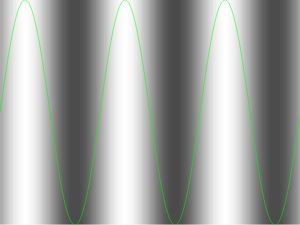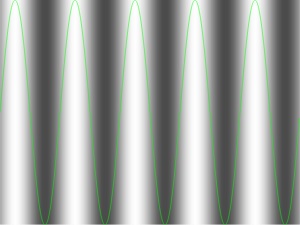
Spatial Frequency Analysis by Retinal Ganglion Cells
Background:
The receptive field of retinal ganglion cells usually consists of two concentric areas -- the center and the surround. These areas act antagonistically -- when light falls on the center of the receptive field, it excites the neuron; light on the surround will inhibit the neuron. It is only when the amount of excitation sufficiently exceeds the amount of inhibition that the neuron will cause an action potential to travel down its axon.
The stimulus that would cause maximum excitation would be a small dot of bright light that completely covered the center but none of the surround. The surround should be entirely in the dark. This type of stimulus rarely occurs in the natural world -- stars in the night sky might be as close as one comes in nature. Thus, it is unlikely that the retinal ganglion cells evolved to detect this type of stimulus.
There is another class of stimuli that retinal ganglion cells respond well to -- sinusoidal gratings. A sinusoidal grating is a series of lighter and darker lines whose intensity is determined by the sine function from trigonometry. The following picture shows a sinusoidal grating with the sine wave that determines the grating's brightness superimposed:

If you viewed the above grating at an appropriate distance so that its image exactly covered 1° of visual angle, then the grating would have a spatial frequency of three -- there are three oscillations of the darker and lighter bars in the figure. (To determine the appropriate distance to get the image of the grating to cover exactly 1° of visual angle, measure the width of the grating on the screen, enter that value in the input box below, and click on the "Get Distance" button.)
Width of grating on screen: View at for the image of the grating to cover 1° of visual angle on your retina. The units for the viewing distance are the same units you used to measure the width of the grating -- if you measured the width of the grating in cm, then the viewing distance is also in cm. If the viewing distance is too large, you can shrink the content of the browser by pressing the control key and, while you are holding it down, pressing the minus key. You can do that several times to make the content smaller and smaller. Re-measure the width of the grating and re-calculate the required viewing distance. Control and the plus key will make the content get bigger. In some browsers Control and the 0 key will return you to 100%.
Sinusoidal gratings can vary in their spatial frequency -- few oscillations of the darker and lighter bars to many oscillations of the darker and lighter bars per given width. The first grating has a lower spatial frequency than the second grating:


Sinusoidal gratings can also differ in their contrast -- the difference between the brightest and darkest parts of the grating. The first grating has a higher contrast that the second grating:


Sinusoidal gratings can also differ in their orientation -- the direction that the darker and lighter areas point. The first grating has a vertical orientation while the second has a 45° orientation.


At this point, you might (should) be thinking that the sinusoidal gratings are even less likely to appear in nature than the small points of light surrounded by darkness (stars at night) that I said was an unlikely choice for the cause of the evolution of the receptive fields of retinal ganglion cells. Unless you have been in a perception experiment or been a student of perception, you probably believe that you have never seen anything like the depictions of the sinusoidal gratings shown above. And, you would be right. And, you would also be wrong. You would be right that sinusoidal gratings by themselves do not appear very often (if ever) in nature or even in things created by humans. However, the sinusoidal gratings are there -- everywhere -- they are just hiding.
Where are the sinusoidal gratings hiding? The great French mathematician and physicist Jean-Baptiste Joseph Fourier (who also discovered the greenhouse effect that Earth is currently undergoing) showed that any function can be decomposed into a series of sine waves. In the visual realm, those sine wave are sinusoidal gratings. Whenever you see a fairly uniform visual field (think of a wall that is painted all the same color, but perhaps one area is slightly brighter than another due to the lights in the room), you are looking at something that primarily contains low spatial frequencies. Whenver you see an edge (where one object stops and another starts), you are looking at something that has high spatial frequencies in its image. Fourier created a procedure for determining the sinusoids in an arbitrary function. If you know the function, you can determine the sinusoidal components; if you know the sinusoidal components, you can exactly recreate the function. The retinal ganglion cells determine the sinusoidal gratings in any given visual image. If you know the image, you can get the sinusoidal gratings; if you know the sinusoidal gratings, you can exactly recreate the image. This process of determining the sinusoidal gratings present in a visual image is called spatial frequency analysis.
The Activity:
In this activity you can change the spatial frequency of a sinusoidal grating and the size of the retinal ganglion cell's receptive field. You can also change the phase of the sinusoidal grating -- this determines whether the grating starts with a dark stripe, a light stripe, or something in-between. Change the phase to keep the center of the receptive field in the lightest (or darkest) part of the grating. Just for fun, you can also toggle the receptive field from on-center off-surround to off-center, on-surround.
In real life the size of the receptive field for a given retinal ganglion cell is fixed -- you cannot make it larger or smaller. When you change the receptive field size in this activity think of it as changing retinal ganglion cells (some have larger and some have smaller receptive fields.)
Your main task is to determine the relationship between spatial frequency and the size of the receptive field that leads to high levels of neural activity in the retinal ganglion cell.
You should
Based on your results, what is the relation between spatial frequency and the receptive field size that responds best to that spatial frequency?
| Spatial Frequency | Phase | Receptive Field Size | ||||||
| Low | High | 0 | 360 | Small | Large | |||
| Off-Center, On-Surround | ||||||||
Spike Train: Use Sounds